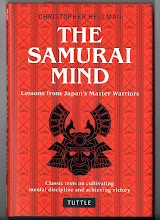
I remember being told once - by an art teacher, speaking in the way that cultural pedants often do, that Ito jakuchu was popular with westerners because he was easy to understand, while 'real' Japanese appreciated a more unique expression of their cultural heritage.
If we put aside the fact that Jakuchu was one of the most popular painters of his time, (although it is also true that his name and works were rescued from obscurity partly through the efforts of the American art collector, Joe Price), the number of visitors at the show of Jakuchu's work, Jakuchu and Kyoto, that was on at the Kyoto Municipal Museum of Art from November to December of this year, certainly puts the lie to that assertion.
Numbered or timed ticketting has not been adopted here, so if you want to visit a popular exhibition, you take your chances and line up (if you're unlucky) or otherwise shuffle round at a dismal speed with the crowds, or flit around some metres away from the glass, hoping to find a gap that allows more than a glimpse of the works.
Although I didn't have to queue, this was the most crowded exhibition I have been to for a long time, and so I opted for the latter.
I flitted past the rows of chickens and cranes and concentrated on just a couple of works - mainly just one, in fact , Elephant and Whale, which I had never seen in the flesh before, and which was the main reason for my visit.
Jakuchu may fairly be calleds a master of ink - the effects he could obtain through brushwork, both careful and dynamic, and with variations in the type of ink itself, make the term 'monochrome' a misnomer. This painting is a good example: although it is executed in shades of ink, to say it is black and white or grey is not an adequate description. The ink has produced a warm and glowing surface that is as alive or perhaps even more so, than his coloured works.
On the left of the pair of six leaved screens the dark form of a whale ploughs through the sea, the smooth line of it's back visible against the wave forms so distinctive of Jakuchu - a powerful jet of water blasts upwards, disappearing out of the picture, to be answered by the trumpetting call of the elephant in the other screen (or at least, a friendly-looking wave of its trunk). Between them lies the sea, like a snowy wasteland.
Indeed, visually, it is very much like a field of snow, gently undulating pale greys, a neutral field on which the action is set. Anyone familiar with Jakuchu's work will be aware of the amount of detail he could cram into his pictures; however, his black and white works tended to leave the background white. Yet this blankness served as a field on which the imagination may project the background he did not paint himself, like an afterimage. His larger works, typically, do not use this approach. Perhaps he judged the size was too great, and perhaps he sought to avoid the deadening effect of such large patches being left unfilled. In fact, his larger works often show extreme attention to enlivening the background, for preserving it as a living field, showing an almost tactile concern with what might otherwise be 'dead space'. This is most evident in his mosaic inspired and 'pointillist' works. While being less satisfying as paintings, this aspect is very much in evidence, and The Elephant and Whale seems, in a less defined (and less exacting way) to follow suit.
 |
| Close up of the waves in the 'Whale' |
This cannot be seen as a lessening of the artist's powers – the fine work on the right hand screen, including the elephants eye and the leaves above its head, show as perfect a degree of control as any of his earlier pieces – the roughness on the whale side is something else, perhaps an expression of the raw power of the leviathan.
Whales are not often depicted in Japanese art - Jakuchu painted at least one other version of this screen himself – an entry for a 1928 catalogue of the Osaka Art Club includes this picture:










